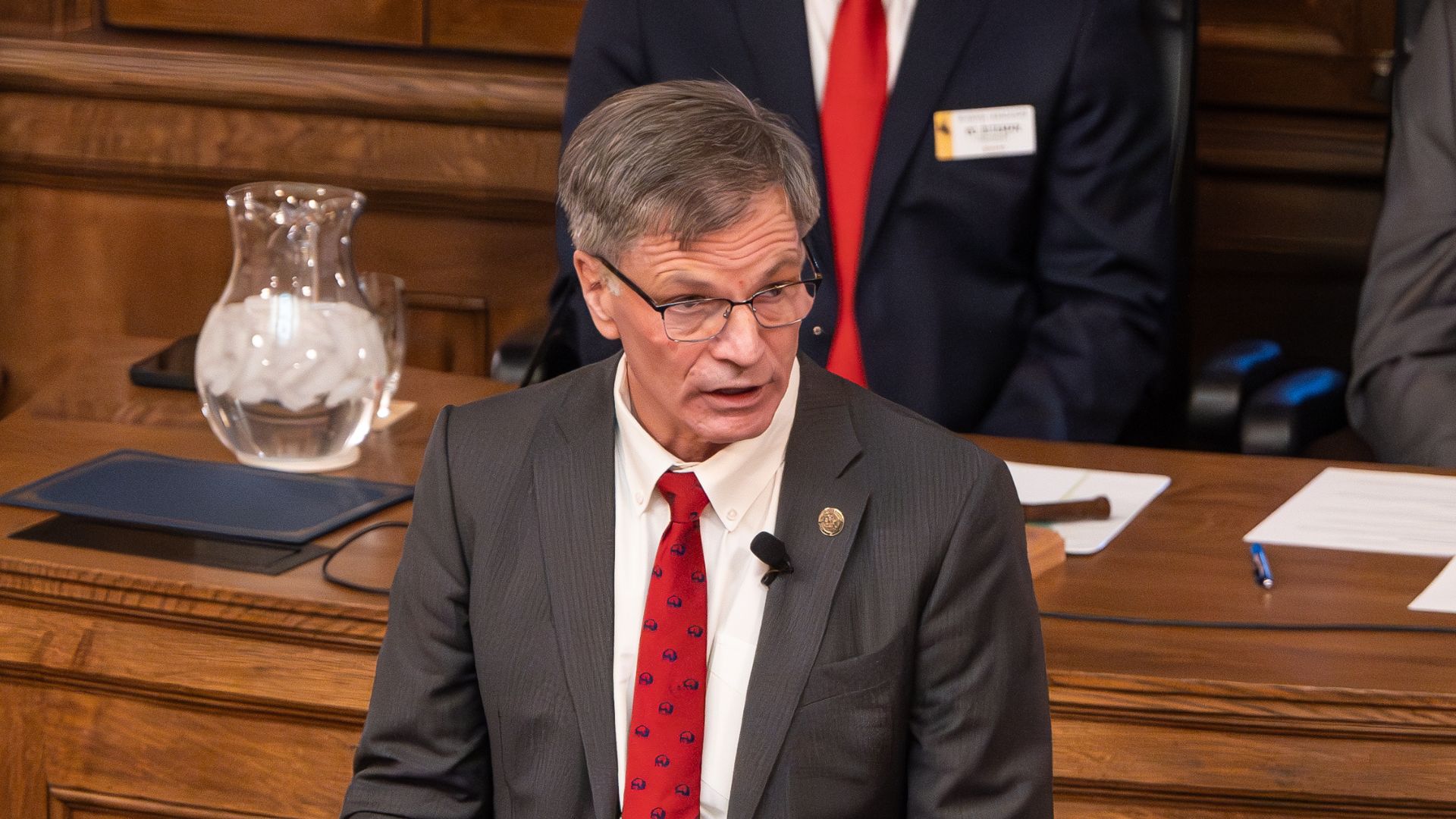Governor: Trade mission to Japan, Taiwan could increase Wyoming fossil fuel exports

Gov. Mark Gordon, photo by Michael Smith
FROM WYOFILE:
Though the islands are interested in Wyoming coal, deals might not come in time to help beleaguered Kemmerer coal mine, Gordon said.
Gov. Mark Gordon recently joined several Wyoming business proprietors at a trade show in Taiwan, where Casper-based Backwards Distilling Company and Gillette-based Big Lost Meadery are highly regarded and very popular, he said. But the popularity of Wyoming spirits wasn’t the main thrust of the visit.
In both Taiwan and Japan, Gordon and other Wyoming dignitaries visited with business and ministry officials who are interested in Wyoming’s coal and natural gas, as well as strengthening partnerships to push carbon capture technologies to help those fossil fuels fit within their low-carbon-emission goals.
Both potential markets rely heavily on energy fuel imports, Gordon said, while officials in Taiwan believe that “about 20% of their energy mix is going to remain with coal and they’re very anxious to get Powder River coal.”
Taiwan has its own elected government, but the People’s Republic of China claims it has sovereignty over the island off its coast.
Gordon called a press conference Wednesday to highlight his trade mission to the region earlier this month. He was joined by officials from the University of Wyoming, Wyoming Energy Authority as well as representatives from energy producers Jonah Energy, Williams Companies and coal-to-products company Kanata Clean Power & Climate Technologies Corp.
“It builds confidence, which is very important in Asia,” Gordon said of the international talks. “And so this leads us to believe that there is a lot of very exciting opportunity.”
One primary tangible outcome Gordon hopes to come of strengthening ties with the two foreign markets is to reinvigorate efforts to build coal and natural gas port terminals to increase the international export of those Wyoming commodities. While the U.S. has increased its capacity to export liquified natural gas, efforts to expand coal ports, particularly on the West Coast, have faltered for years.
But Gordon believes that with public-private investment, along with policy support from President Donald Trump, those efforts will be revitalized.
It will require “looking at whether the Millennium Bulk Terminal can be reinvigorated, or Jordan Cove [terminal] or whether a couple of these other things in Oakland that have been talked about from time to time could come to fruition,” Gordon said. Increasing Wyoming’s fossil fuel exports might also require “going out of the Gulf of America [Gulf of Mexico] and going through the Panama Canal,” he added.
Asked whether the state’s trade efforts might help the beleaguered Kemmerer coal mine land export contracts in time to save it from potentially closing, Gordon said, “I don’t have a silver bullet for that right now. But I can tell you, I’m rummaging around in my ammo box for it.”
Carbon capture hopes and Kemmerer coal
Kemmerer Operations LLC recently laid off 28 workers, and many in southwest Wyoming worry there may be more job losses, or that the mine might even close.
The mine’s biggest customer — the nearby Naughton power plant, which accounts for about 42% of the mine’s coal production, according to federal documents — will stop burning coal by the end of the year as its owner, PacifiCorp, converts the plant to natural gas fuel.
There remains a mix of hope and skepticism for two proposals to tap the Kemmerer coal mine for coal-to-products projects — potentially making up for the pending loss of the Naughton coal contract. In fact, an official from Kanata Clean Power & Climate Technologies Corp. joined Gordon on the Japan and Taiwan trade mission.
The company proposes a multi-billion-dollar effort to cleanly convert about 1.8 million tons of Kemmerer coal annually into ammonia, primarily as an agricultural fertilizer. Another company, TriSight LLC, claims to have “unlocked” a process to convert the coal into myriad products, including graphite, agricultural fertilizer and makeup — using about 1 million tons per year from the Kemmerer mine, all while avoiding coal’s typical carbon emissions.
But neither project appears on the Wyoming Industrial Siting Council’s working list of applications — a required regulatory step for such projects. Taken at face value, the lack of an ISC permit application indicates that neither proposal is likely to consume Kemmerer coal within the next year or so.
“The Wyoming coal-to-ammonia project team is evaluating multiple siting alternatives, a list of alternatives that includes the Kemmerer mine surface lease,” F.E. “Wally” Wolski, who works with Kanata, told WyoFile via email.
Although WyoFile has not fully investigated the financial preparedness of either TriSight or Kanata, some southwest Wyoming officials regard both coal-to-products proposals as a potential lifeline for the mine. Kemmerer City Administrator Brian Muir told WyoFile that both projects underscore signs of a potential rebound in the coal market and the potential for technologies to find new uses for coal.
“This is not over yet,” Muir told WyoFile in March. “There’s years and years of coal reserves here, and technologies to convert [coal into products].”
Among the most exciting topics discussed on his trade mission to Japan and Taiwan, Gordon said, was an agreement to support coal technologies that reduce its carbon footprint.
“[We talked] about the progression of technologies that could go forward, and that generated a lot of excitement,” Gordon said.
WyoFile is an independent nonprofit news organization focused on Wyoming people, places and policy.
This story was posted on May 1, 2025.







